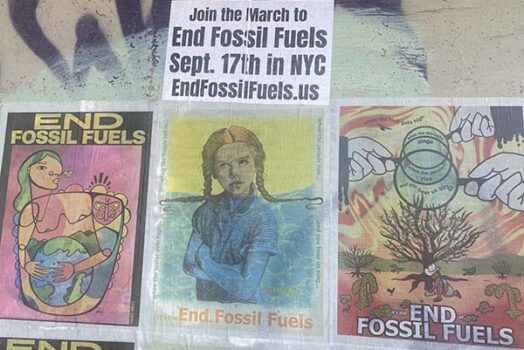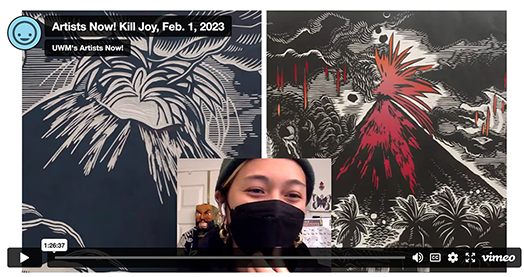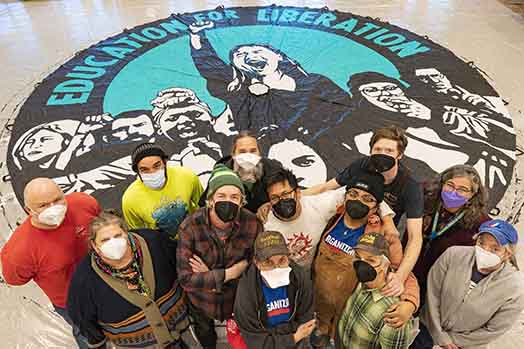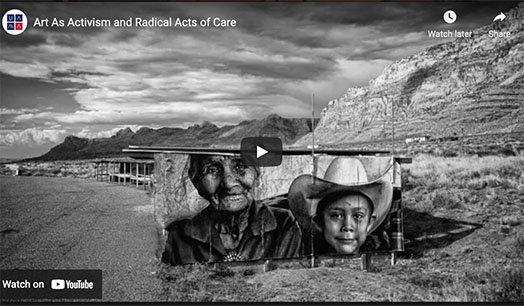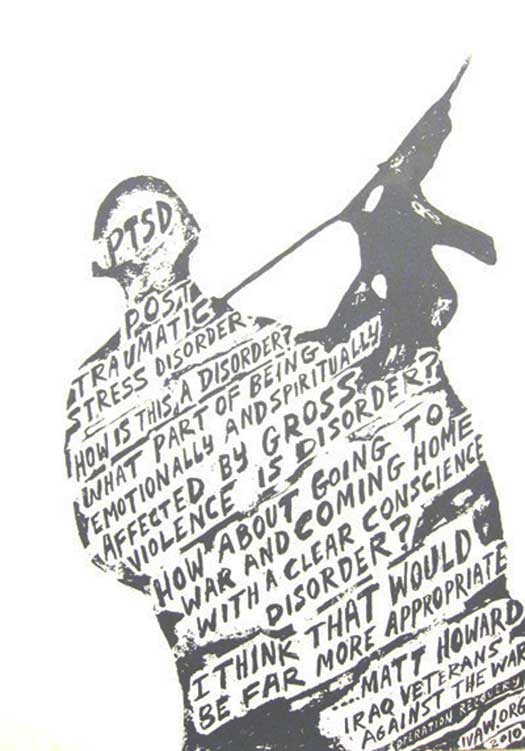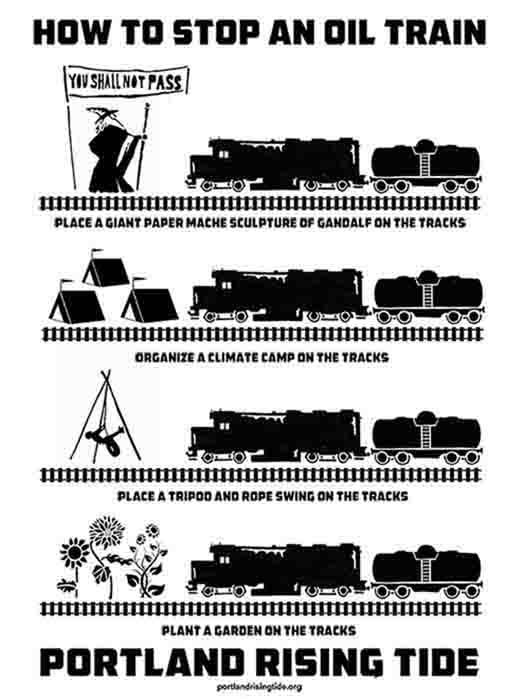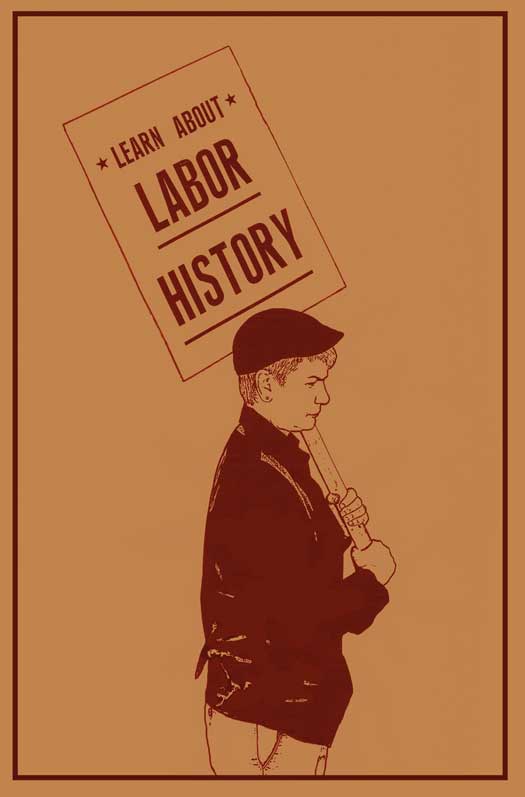
SNCC poster, Is He Protecting You?, ca. 1963, Photograph by Danny Lyon (copyright Dany Lyon / Magnum Photos: image from Tamiment Library and Robert F. Wagner Labor Archives and Radicalism Photograph Collection. Tamiment Library, New York University
This year marks the 50th Anniversary of Freedom Summer – or the Mississippi Summer Project. Here is an excerpt from A People’s Art History of the United States that discusses the history and the role of photographers who documented the movement- specifically Danny Lyon and SNCC Photo. The excerpt starts at the mid-point of the chapter.
Mississippi
When you made a move on Mississippi, one of the things you had to do was come to grips with your own mortality…This is not going to be big demonstrations with lots of television cameras with people around watching…when we went on those highways in the middle of the night…you had to think that you would never live to see your home again.
—Charles McDew, SNCC
In the summer of 1960, SNCC organizer Bob Moses toured Alabama, Mississippi, and Louisiana to seek out and cultivate local leaders. In Cleveland, Mississippi, he met Amzie Moore, head of the Cleveland NAACP. Moore persuaded him that the greatest asset that SNCC could provide them was to help organize a voter registration campaign. Moses agreed, and by August 1961, SNCC opened its first voter registration school in McComb, right in the heart of Klan country. By fall 1962, Moses was in charge of six offices and twenty field secretaries. He described his philosophy as such:
You dig into yourself and into the community to wage psychological warfare, you combat your own fears about beatings, shootings and possible mob violence; you stymie, by your mere physical presence, the anxious fear of the Negro community . . . you organize, pound by pound, small bands of people . . . you create a small striking force . . . The deeper the fear, the deeper the problems in the community, the longer you have to stay to convince them.
Fear was an understatement, for violence upheld white supremacy. On June 12, 1963, Mississippi NAACP leader Medgar Evers was assassinated by a gunshot blast to his back. The year before, federal protection was required to guard James Meredith when he became the first African American to enroll at the University of Mississippi. White students rioted. Two people were killed, 160 people were injured, and 28 gunshot wounds were reported. The majority of those wounded were federal marshals.
This was the climate that SNCC operated in when they chose Mississippi to be their primary location to launch a voter registration drive. SNCC offices were firebombed and SNCC workers were routinely jailed, beaten, and shot at. Some were killed. SNCC fieldworker Frank Smith stated, “There is no protection against Mississippi . . . Only the Federal government can protect us and it won’t.”
One would expect that the vast majority of photographs that SNCC took in Mississippi would have docu mented the extreme levels of violence and police brutality. Instead, the oppo site was the case. The majority of photo graphs that Lyon and other SNCC photographers took were images of organizing drives and movement-building: mass meetings, literacy training workshops, canvassing, voter-registration drives, and time spent simply hanging out together.
Lyon’s photographs in 1963 include, among others, an image of James Forman talking on the phone inside the Greenwood office; Bob Moses, Charles Sherrod, and Randy Battle conversing with an elderly woman on her porch during a voter-registration drive in rural Georgia; and a young Bob Dylan playing guitar behind the Greenwood office while a small crowd gathers, some listening, some talking among themselves.
What is so remarkable about these images is how ordinary the scenes are. One would never get the sense that these individuals were operating within one of the most dangerous counties in the United States. They are almost contemplative, lacking any sense of fear or violence—the antithesis of the types of photographs that mainstream media outlets were running in their coverage of the civil rights movement. Instead, Lyon’s images project the “nit-and- grit” of daily organizing work, by the people who built the civil rights movement.
The reality of life behind the work was quite different, of course, in a place where simply possessing a camera could lead to arrest or worse. In 1962, Lyon was arrested in Cleveland, Mississippi, for taking photographs in the street near Amzie Moore’s house. The police officer told Lyon that he had to pay $1,000 bond to be “engaged in the business of photography.” His final warning to Lyon after letting him go: “If I see you anywhere I’m going to kill you.”
Mississippi Summer Project
Lyon did not heed the police officer’s advice. He returned regularly to Mississippi throughout 1963 and 1964 and photographed SNCC activities throughout the state. In 1964, he documented SNCC’s most ambitious and controversial activity to date—the Mississippi Summer Project.
In late 1963, SNCC laid the groundwork for a summer campaign that was designed with three goals: a statewide voter-registration drive, the establishment of freedom schools throughout the state, and the formation of a new political party—the Mississippi Freedom Democratic Party.
The most controversial aspect of the plan was the recruitment of 1,000 white, middle-class college students, primarily from northern states, who would fill the volunteer ranks. Many in SNCC felt that the addition of so many white volunteers would disrupt SNCC’s race and class balance. SNCC was a black-led organization, and many of its positions in Mississippi were filled by those who were native to the state and had grown up as sharecroppers. Bob Moses, the director of the Summer Project, held the final word in the matter; he would not be part of an organization that was not integrated.
There were also tactical reasons for bringing in thousand white volunteers. The mass media would scarcely cover events taking place in rural Mississippi, so SNCC reasoned that the “heated atmosphere caused by the presence of many volunteers, especially whites, would force the federal government to intervene—possibly with the use of troops.” Confrontation would result in media attention. Forman asserted:
White people should know the meaning of the work we were doing—they should feel some of the suffering and terror and deprivation that black people have endured. We could not bring all of white America to Mississippi. But by bringing in some of its children as volunteer workers, a new consciousness would feed back into the homes of thousands of white Americans as they worried about their sons and daughters confronting “the jungle of Mississippi,” the bigoted sheriffs, the Klan, the vicious White Citizens’ Councils.
In early 1964, SNCC began visiting northern college campuses to recruit students. Each volunteer had his or her portrait taken and was asked to fill out a list with “names of the applicants’ Congressional representatives, the names of their college and hometown newspapers…organizations they belonged to…and ten people who would be interested in receiving information about their activities.”
The worst possible news to report came early on. On June 21, days before many of the volunteers had arrived in Mississippi, three civil rights workers disappeared—two affluent white college students from New York (Michael Schwerner and Andrew Goodman) and one black Mississippian (James Chaney). The three had been arrested by the police in Philadelphia, Mississippi, and released late at night into the waiting hands of the Klan, who worked in collusion with the local police sheriffs.
The FBI found their bodies six weeks later. Each had been shot at point-blank range. The terrible outcome and the fear that it generated might have scared away many of the summer volunteers, but the opposite occurred. It strengthened their resolve. SNCC itself grew stronger, and its work expanded.
SNCC’s emphasis on photography also grew in 1963 and 1964. Lyon was no longer the principal SNCC photographer. SNCC Photo was established and enlisted more than a dozen photographers to also document the movement. The multiracial group in cluded black photographers Clifford Vaughs, Joffre Clark, Fred deVan, Rufus Hinton, Bon Fletcher, Julius Lester, Norris McNa mara, and Francis Mitchell; the Latina photographer Mary Varela; the Japanese Canadian photographer Tamio “Tom” Wakayama; and the white photographer Dee Gorton. Additionally, Matt Herron, a white photojournalist from New York, organized the Southern Documentary Project, modeled after the Farm Security Administration’s (FSA) photography work in the 1930s. The driving concept behind the project was to document organizing activities other than demonstrations—in other words, everyday life. For a project adviser, Herron consulted with Dorothea Lange.
Other photography “heavyweights” who lent assistance to SNCC included Richard Avedon, who helped train a number of SNCC photographers in his studio. He also convinced Marty Forscher, the owner of a famous camera shop in NYC, to donate film and more than seventy-five cameras to SNCC over a three-year period.
As photographers spread out across Mississippi and the southeast, darkrooms were built in Tougaloo, Mississippi, and Selma, Alabama. Photographers became active participants in the movement. According to Leigh Raiford, “Almost all served in the field on voter registration, literacy training or direct action programs, visually documenting the people they worked with and the events, demonstrations, and projects they helped organize.”
Some of the images produced that summer included one by Matt Herron that documents a freedom school in Mileston—one of forty-one schools that were established that summer in Mississippi and were attended by more than 2,000 students. Other images depict door-to-door canvassing. During the course of the summer 1,600 African Americans were successfully registered to vote out of the approximately 17,000 who attempted to do so. But the numbers are misleading. Long-term gains ultimately eclipsed short-term loses. A flood of media attention focused upon Mississippi when Schwerner, Goodman, and Chaney went missing. During the Summer Project, the SNCC Jackson office received two to three visits or calls per day from the AP, UPI, NBC, ABC, and CBS, along with extensive reports in the New York Times and the Washington Post, among others. As a result of the media rush and the organizing campaign, the stranglehold that whites had over state and local politics began to crumble in the years that followed as more and more African Americans registered to vote and black candidates were elected into public office.
Following the Summer Project, SNCC would undergo a sea change. A week-long SNCC staff meeting in Waveland, Mississippi, in November ended with eighty-five new members— mostly white, northern college students who had been with the organization for less than six months—being added to the staff. This decision ruptured the racial and class composition of the group and led to future tensions that would tear the organization apart. Lyon left after the Summer Project. The SNCC that would emerge would become almost unrecognizable to him, and many others. In December 1966, Stokely Carmichael replaced John Lewis as SNCC’s chairman. Nonviolence became a thing of the past. SNCC now stood for black power and the right to self-defense. By 1969, SNCC fell apart, for all intents and purposes, but their legacy and many accomplishments remain intact. From an art perspective, SNCC stands as one of the rare examples of a social justice organization that placed a premium on artists as key contributors within a movement. SNCC understood how images worked, and how they should be disseminated. While most organizations let outsiders from the mainstream press cover their struggles, SNCC knew better. It created staff positions for photographers—a decision that aided the movement and enriched the lives of the artists who joined their ranks. In a letter to his parents in February 1964, Danny Lyon wrote, “The Danville pamphlet, a poster that makes money for SNCC, even selling pictures and passing the check on to SNCC; these things have, for a brief moment given me a satisfaction previously unknown to me.”
http://peoplesarthistoryus.org/
http://justseeds.org/nicolas_lampert/03pahbook.html
Three highly recommended books on SNCC and photography:
Danny Lyon, Memories of the Southern Civil Rights Movement, Chapel Hill: The University of North Carolina Press, 1992
Leslie G. Kelen, editor, This Light of Ours: Activist Photographers of the Civil Rights Movement, Jackson: University of Mississippi Press, 2011
Vanessa Murphree, The Selling of Civil Rights: The Student Nonviolent Coordinating Committee and the Use of Public Relations, New York: Routledge, 2006
